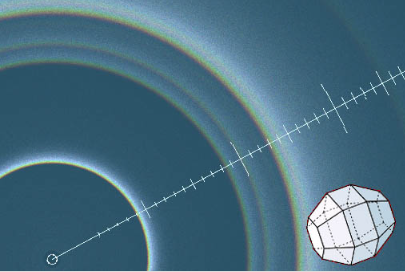Circular Halos from Pyramidal Crystals
Circular Halos from Pyramidal Crystals: Unveiling the Enigmatic Phenomena
Have you ever looked up at the sky and noticed mysterious circular halos that defy explanation? These enigmatic optical phenomena, known as "Odd radius halos," often appear alongside the familiar 22° halo. While the latter can be attributed to hexagonal prism ice crystals, the origins of these circular halos remain shrouded in mystery. In this article, we will delve into the captivating world of circular halos produced by pyramidal ice crystals and shed light on their fascinating characteristics.
Pyramidal ice crystals are unique structures in which one or both end faces of ordinary ice crystals are replaced by six-sided pyramids. These pyramids can be truncated, and the central prism section may even be missing, resulting in a staggering array of 18 different variations with up to 20 sides. Surprisingly, it is highly likely that all hexagonal ice crystals are, in fact, pyramidal crystals with insignificantly small inclined facets.
Unlike ordinary prism crystals, where the angles between faces are limited to 60° or 90°, pyramidal crystal faces can exhibit a range of angles such as 28°, 52.4°, 56°, 62°, 63.8°, and 80.2°. Each of these inclination or dihedral angles gives rise to a distinct circular halo, contributing to the diverse range of odd radius halos observed in the atmosphere.
The odd radius halos are classified as minimum deviation phenomena, similar to the more commonly known 22° and 46° halos. The relative intensities of these halos, or whether they appear at all, depend on the presence and relative sizes of specific sets of faces within the pyramidal crystals. This intricate interplay of crystal geometry and light refraction leads to the mesmerizing display of circular halos in the sky.
Contrary to popular belief, odd radius halos are not as rare or "odd" as previously thought. In fact, they may be more prevalent than we realize. By actively searching for these halos during atmospheric observations, we can unravel the true extent of their occurrence and gain a deeper understanding of their formation processes.
To summarize the key points about circular halos from pyramidal crystals:
- Circular halos that cannot be explained by hexagonal prism crystals are known as odd radius halos.
- Pyramidal ice crystals have one or both end faces replaced by six-sided pyramids, resulting in a multitude of variations.
- The angles between pyramidal crystal faces can range from 28° to 80.2°, giving rise to different circular halos.
- Odd radius halos are minimum deviation phenomena, similar to the 22° and 46° halos.
- The presence and relative sizes of specific sets of faces within pyramidal crystals determine the appearance and intensity of odd radius halos.
- Actively searching for odd radius halos can help us better understand their prevalence and characteristics.
In conclusion, circular halos from pyramidal crystals add a touch of mystery and intrigue to the atmospheric optics phenomena. Exploring these captivating optical displays opens up new avenues for scientific inquiry and encourages us to look beyond the familiar to uncover the secrets of our ever-changing skies. So, next time you gaze up at the heavens, keep an eye out for the elusive odd radius halos and let their ethereal beauty inspire your curiosity.

Circular halos from poorly oriented pyramidal crystals swamp the everyday 22� halo in this 90 million ray simulation. Outwards from the sun are 9,18,20,23,24 and 35� radius halos. Sometimes called "Odd radius halos".
Sometimes circular halos appear that cannot be explained by invoking 'ordinary' hexagonal prism crystals.
These are the 'Odd radius halos' produced by pyramidal ice crystals. Pyramidal crystals have one or both end faces of ordinary ice crystals replaced by six sided pyramids. The pyramids are sometimes truncated and the central prism section is sometimes missing, creating 18 different variations with up to 20 sides. Very likely, all hexagonal ice crystals are actually pyramidal but with insignificantly small inclined facets.
In contrast to ordinary prism crystals where the angles between faces are either 60 or 90�, the angles between pyramidal crystal faces can also be 28, 52.4, 56, 62, 63.8 and 80.2�. Each inclination or dihedral angle forms a separate circular halo.
The odd radius halos are all minimum deviation phenomena like the more familiar 22 and 46� halos. Their relative intensities - or whether some appear at all - depend on the presence and relative sizes of particular sets of faces.
Odd radius halos are perhaps not so 'odd' or rare as usually thought. Make a point of routinely searching for them.
Note: this article has been automatically converted from the old site and may not appear as intended. You can find the original article here.
Reference Atmospheric Optics
If you use any of the definitions, information, or data presented on Atmospheric Optics, please copy the link or reference below to properly credit us as the reference source. Thank you!
-
<a href="https://atoptics.co.uk/blog/circular-halos-from-pyramidal-crystals/">Circular Halos from Pyramidal Crystals</a>
-
"Circular Halos from Pyramidal Crystals". Atmospheric Optics. Accessed on December 21, 2024. https://atoptics.co.uk/blog/circular-halos-from-pyramidal-crystals/.
-
"Circular Halos from Pyramidal Crystals". Atmospheric Optics, https://atoptics.co.uk/blog/circular-halos-from-pyramidal-crystals/. Accessed 21 December, 2024
-
Circular Halos from Pyramidal Crystals. Atmospheric Optics. Retrieved from https://atoptics.co.uk/blog/circular-halos-from-pyramidal-crystals/.